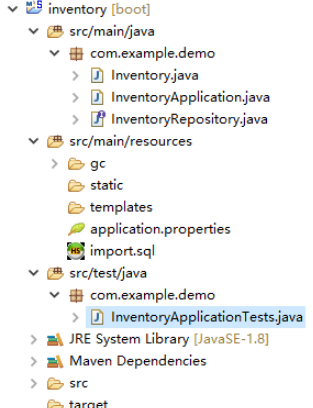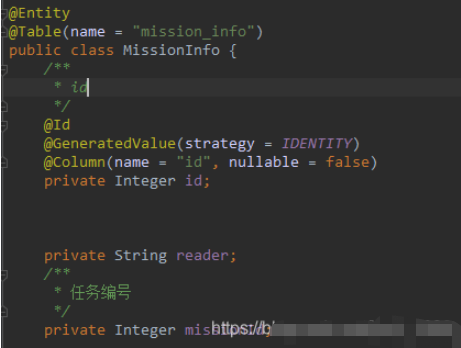这篇文章主要介绍“springboot jpaRepository为什么一定要对Entity序列化”,在日常操作中,相信很多人在springboot jpaRepository为什么一定要对Entity序列化问题上存在疑惑,小编查阅了各式资料,整理出简单好用的操作方法,希望对大家解答”springboot jpaRepository为什么一定要对Entity序列化”的疑惑有所帮助!接下来,请跟着小编一起来学习吧!
一开始,我没有对实体类Inventory序列化,导致在使用内嵌数据库H2的JPA时,它直接安装字母序列把表Inventory的字段生成。
举例,原来我按照
inventory(id, name, quantity, type, comment)
顺序写的数据库导入表,但是因为没有序列化,导致表结构变成
inventory(id, comment,name, quantity, type )
所以后面JPA处理失败。
顺便记录一下写spring cloud 基于和H2 database的jpa简单restful 程序。
实体类Inventory
package com.example.demo;
import java.io.Serializable;
import javax.persistence.Column;
import javax.persistence.Entity;
import javax.persistence.GeneratedValue;
import javax.persistence.Id;
import javax.persistence.SequenceGenerator;
@Entity
public class Inventory implements Serializable{
private static final long serialVersionUID = 1L;
@Id
@SequenceGenerator(name="inventory_generator", sequenceName="inventory_sequence", initialValue = 2)
@GeneratedValue(generator = "inventory_generator")
private Integer id;
@Column(nullable = false)
private String name;
@Column(nullable = false)
private Integer quantity;
@Column(nullable = false)
private Integer type;
@Column(nullable = false)
private String comment;
public Inventory(Integer id, String name, Integer quantity, Integer type, String comment) {
super();
this.id = id;
this.name = name;
this.quantity = quantity;
this.type = type;
this.comment = comment;
}
public Inventory() {
super();
}
public Integer getId() {
return id;
}
public void setId(Integer id) {
this.id = id;
}
public String getName() {
return name;
}
public void setName(String name) {
this.name = name;
}
public Integer getQuantity() {
return quantity;
}
public void setQuantity(Integer quantity) {
this.quantity = quantity;
}
public Integer getType() {
return type;
}
public void setType(Integer type) {
this.type = type;
}
public String getComment() {
return comment;
}
public void setComment(String comment) {
this.comment = comment;
}
@Override
public String toString() {
return "Inventory [id=" + id + ", name=" + name + ", quantity=" + quantity + ", type=" + type + ", comment="
+ comment + "]";
}
}下面使用JpaRepository简化开发流程,非常舒服地定义简单的service 接口即可,会自动实现,大赞。
package com.example.demo;
import org.springframework.data.jpa.repository.JpaRepository;
public interface InventoryRepository extends JpaRepository<Inventory, Integer> {
Inventory findById(Integer id);
}我把controller方法放到了springboot启动类里面,这又是一个大问题,因为我的项目只有放在这才能被dispatcher转发,简直了。
这里的@EnableDiscoveryClient 是因为我在做spring cloud的eureka 服务发现,需要这个注解让注册中心发现这个服务。
package com.example.demo;
import java.time.LocalTime;
import org.springframework.beans.factory.annotation.Autowired;
import org.springframework.beans.factory.annotation.Value;
import org.springframework.boot.SpringApplication;
import org.springframework.boot.autoconfigure.SpringBootApplication;
import org.springframework.cloud.client.discovery.EnableDiscoveryClient;
import org.springframework.transaction.annotation.Transactional;
import org.springframework.web.bind.annotation.GetMapping;
import org.springframework.web.bind.annotation.PathVariable;
import org.springframework.web.bind.annotation.RequestMapping;
import org.springframework.web.bind.annotation.ResponseBody;
import org.springframework.web.bind.annotation.RestController;
@SpringBootApplication
@EnableDiscoveryClient
@RestController
public class InventoryApplication {
public static void main(String[] args) {
SpringApplication.run(InventoryApplication.class, args);
}
@Autowired
private InventoryRepository inventoryRepository;
@Value("${server.port}")
private Integer port;
@RequestMapping("/info")
public String info(){
inventoryRepository.save(new Inventory(1, "火锅底料", 10000, 1, "你吃火锅,我吃底料"));
inventoryRepository.save(new Inventory(2, "微服务架构", 100, 2, "微服务还是要考虑 一波"));
return "{Inventory[port:"+port+", info:库存微服务"+"]}";
}
@GetMapping("/get/{id}")
@ResponseBody
@Transactional
public String getById(@PathVariable("id")Integer id){
return inventoryRepository.findById(id).toString();
}
@GetMapping("/")
@ResponseBody
@Transactional
public String re(){
return inventoryRepository.findAll().toString();
}
@GetMapping("/delete/{id}")
@ResponseBody
@Transactional
public String delete(@PathVariable("id")Integer id){
inventoryRepository.delete(id);
return "delete successfully";
}
@GetMapping("/save/id={id}&name={name}&quantity={quantity}&type={type}&comment={comment}")
/* @ResponseBody
@Transactional*/
public String save(@PathVariable("id")Integer id,@PathVariable("name")String name,
@PathVariable("quantity")Integer quantity,@PathVariable("type")Integer type,
@PathVariable("comment")String comment){
inventoryRepository.save(new Inventory(id,name,quantity,type,comment));
System.out.println(new Inventory(id,name,quantity,type,comment));
//强调一下identity和auto
return "save successfully";
}
@GetMapping("/update/id={id}&name={name}&quantity={quantity}&type={type}&comment={comment}")
@ResponseBody
@Transactional
public String update(@PathVariable("id")Integer id,@PathVariable("name")String name,
@PathVariable("quantity")Integer quantity,@PathVariable("type")Integer type,
@PathVariable("comment")String comment){
Inventory inventory=inventoryRepository.findById(id);
if(inventory.getComment().length()<LocalTime.now().toString().length()){
inventory.setComment(inventory.getComment()+LocalTime.now());
}else{
inventory.setComment(inventory.getComment().substring(0,inventory.getComment().length()-
LocalTime.now().toString().length())+LocalTime.now());
}
inventoryRepository.save(inventory);
inventoryRepository.flush();
return "update successfully";
}
}application.properties的配置很关键,搜了不少教程。
spring.jpa.show-sql=true
logging.pattern.level=trace
server.port=8765
spring.application.name=inventory
server.tomcat.max-threads=1000
eureka.instance.leaseRenewalIntervalInSeconds= 10
eureka.client.registryFetchIntervalSeconds= 5
eureka.client.serviceUrl.defaultZone=http://localhost:8889/eureka
#eureka.client.service-url.defaultZone=http://${eureka.instance.hostname}:${eureka.instance.server.port}/eureka
#spring.thymeleaf.prefix=classpath:/templates/
#spring.thymeleaf.suffix=.html
#spring.thymeleaf.mode=HTML5
#spring.thymeleaf.encoding=UTF-8
# ;charset=<encoding> is added
#spring.thymeleaf.content-type=text/html
# set to false for hot refresh
spring.h3.console.enabled=true
spring.thymeleaf.cache=false
spring.jpa.hibernate.ddl-auto=update
#这里是把h3持久化到本地文件夹,这可以保持数据
spring.datasource.url=jdbc:h3:file:C\:/h3/h3cache;AUTO_SERVER=TRUE;DB_CLOSE_DELAY=-1
logging.file=c\:/h3/logging.log
logging.level.org.hibernate=debug
#spring.datasource.data=classpath:import.sql数据库是自动导入的,只要命名方式是import.sql, 放在src/main/resources下面就可以
insert into inventory(id, name, quantity, type, comment) values (1, "火锅底料", 10000, 1, "你吃火锅,我吃底料") insert into inventory(id, name, quantity, type, comment) values (2, "微服务架构", 100, 2, "微服务还是要考虑 一波")
junit测试一波
package com.example.demo;
import org.junit.Test;
import org.junit.runner.RunWith;
import org.springframework.beans.factory.annotation.Autowired;
import org.springframework.boot.test.context.SpringBootTest;
import org.springframework.test.context.junit4.SpringRunner;
@RunWith(SpringRunner.class)
@SpringBootTest
public class InventoryApplicationTests {
@Autowired
private InventoryRepository inventoriRepository;
@Test
public void test2() {
System.out.println(inventoriRepository.findAll());
}
}
上图是项目结构图
在对数据库操作时使用 MissionInfoRepository,对应的实体类必须用下面两个注解修饰
@Entity @Table(name = "mission_info")
主键用下面修饰
@Id @GeneratedValue(strategy = IDENTITY) @Column(name = "id", nullable = false)

到此,关于“springboot jpaRepository为什么一定要对Entity序列化”的学习就结束了,希望能够解决大家的疑惑。理论与实践的搭配能更好的帮助大家学习,快去试试吧!若想继续学习更多相关知识,请继续关注亿速云网站,小编会继续努力为大家带来更多实用的文章!
免责声明:本站发布的内容(图片、视频和文字)以原创、转载和分享为主,文章观点不代表本网站立场,如果涉及侵权请联系站长邮箱:is@yisu.com进行举报,并提供相关证据,一经查实,将立刻删除涉嫌侵权内容。